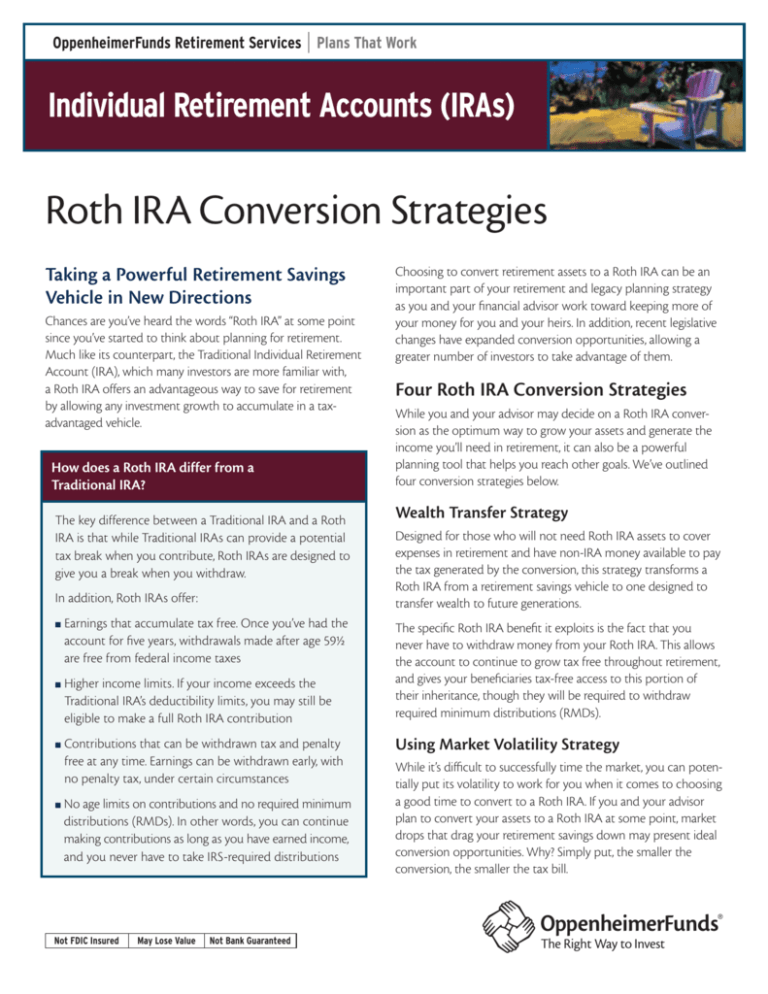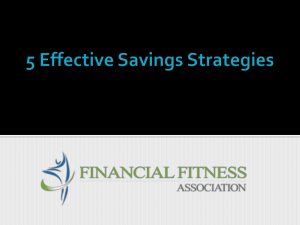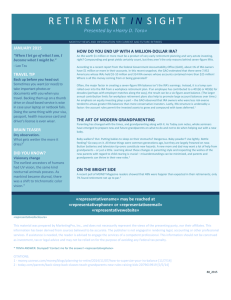
OppenheimerFunds Retirement Services Plans That Work
Individual Retirement Accounts (IRAs)
Roth IRA Conversion Strategies
Taking a Powerful Retirement Savings
Vehicle in New Directions
Chances are you’ve heard the words “Roth IRA” at some point
since you’ve started to think about planning for retirement.
Much like its counterpart, the Traditional Individual Retirement
Account (IRA), which many investors are more familiar with,
a Roth IRA offers an advantageous way to save for retirement
by allowing any investment growth to accumulate in a taxadvantaged vehicle.
How does a Roth IRA differ from a
Traditional IRA?
The key difference between a Traditional IRA and a Roth
IRA is that while Traditional IRAs can provide a potential
tax break when you contribute, Roth IRAs are designed to
give you a break when you withdraw.
In addition, Roth IRAs offer:
n
n
n
n
E arnings that accumulate tax free. Once you’ve had the
account for five years, withdrawals made after age 59½
are free from federal income taxes
igher income limits. If your income exceeds the
H
Traditional IRA’s deductibility limits, you may still be
eligible to make a full Roth IRA contribution
ontributions that can be withdrawn tax and penalty
C
free at any time. Earnings can be withdrawn early, with
no penalty tax, under certain circumstances
o age limits on contributions and no required minimum
N
distributions (RMDs). In other words, you can continue
making contributions as long as you have earned income,
and you never have to take IRS-required distributions
Not FDIC Insured
May Lose Value
Not Bank Guaranteed
Choosing to convert retirement assets to a Roth IRA can be an
important part of your retirement and legacy planning strategy
as you and your financial advisor work toward keeping more of
your money for you and your heirs. In addition, recent legislative
changes have expanded conversion opportunities, allowing a
greater number of investors to take advantage of them.
Four Roth IRA Conversion Strategies
While you and your advisor may decide on a Roth IRA conversion as the optimum way to grow your assets and generate the
income you’ll need in retirement, it can also be a powerful
planning tool that helps you reach other goals. We’ve outlined
four conversion strategies below.
Wealth Transfer Strategy
Designed for those who will not need Roth IRA assets to cover
expenses in retirement and have non-IRA money available to pay
the tax generated by the conversion, this strategy transforms a
Roth IRA from a retirement savings vehicle to one designed to
transfer wealth to future generations.
The specific Roth IRA benefit it exploits is the fact that you
never have to withdraw money from your Roth IRA. This allows
the account to continue to grow tax free throughout retirement,
and gives your beneficiaries tax-free access to this portion of
their inheritance, though they will be required to withdraw
required minimum distributions (RMDs).
Using Market Volatility Strategy
While it’s difficult to successfully time the market, you can potentially put its volatility to work for you when it comes to choosing
a good time to convert to a Roth IRA. If you and your advisor
plan to convert your assets to a Roth IRA at some point, market
drops that drag your retirement savings down may present ideal
conversion opportunities. Why? Simply put, the smaller the
conversion, the smaller the tax bill.
1234
Plus, as the markets recover (and historically, they have over
time), any earnings will accumulate tax free, and remain so for
any qualified distributions you choose to take.
Maximizing Tax Incentives Strategy
In order for taxpayers to take advantage of certain special tax
attributes, such as business losses or college tax credits, they
must have taxable income. If you find yourself in a position
where you need to generate taxable income, a Roth IRA
conversion may potentially be the answer.
The key to this strategy is working with your tax or financial
advisor to ensure you convert just enough to generate taxable
income, not an even larger tax bill. As with any tax strategy, you
always should consult with an expert.
Tax Hedging Strategy
You and your advisor may conclude that your income tax rate
will likely be higher in the future for a number of reasons. This
could happen once you begin to draw income from your
retirement accounts (whether via RMDs or other sources), if you
are relatively young and expect salary increases, or if you think
tax rates will increase in the future. If this is the case, converting
to a Roth IRA and paying the taxes sooner rather than later may
save you money while allowing you the potential of continued
growth without the burden of taxes.
This strategy may also be effective for those who plan to leave
at least some money in retirement accounts as part of their
legacy plan, and believe that the income and estate tax on a
Traditional IRA will be higher than the tax bill from a Roth IRA
conversion. Paying the taxes now may mean more money for
your beneficiaries and less for the tax man.
Keeping More for You and Your Heirs
Regardless of the strategy behind your conversion, it’s important
to work closely with your financial advisor when it comes to
deciding how much to convert.
As discussed above, the main factor to consider is your likely
future income tax rate. Based on this, many advisors will
calculate an amount designed to trigger a tax rate equal to or
less than this future rate.
A second factor is time. As discussed earlier, because
you never have to withdraw the money from a Roth IRA,
the more money you convert, and the earlier you convert it,
the greater the potential impact of time and compounding
(earnings generated from earnings). This may mean more
retirement savings available for you and/or additional wealth
for your beneficiary.
In fact, depending on the age of your beneficiaries when they
inherit, the amount you and your advisor choose to convert
may have the opportunity to grow substantially before your
beneficiary’s RMDs begin—RMDs which are tax free, remember.
Considering Roth IRA conversion?
If you’re considering converting retirement assets from a
Traditional IRA or an employer-sponsored retirement plan,
such as a 401(k), you and your advisor should consider the
following questions.
n
n
n
n
n
n
n
n
Do you expect tax rates to increase over time?
o you expect to be in a higher tax bracket when
D
you retire?
How will you cover the taxes incurred by a conversion?
ill you need your IRA assets to cover annual living
W
expenses in retirement?
Is leaving a legacy part of your financial goals?
ave your retirement savings suffered losses due to
H
market conditions?
o you think you may need to withdraw any of your
D
contributions before age 59½?
ould you like to continue contributing to an IRA after
W
age 70½?
Legislative Changes Expand Conversion
Opportunities
During your discussions with your financial advisor, be sure to
ask about the Pension Protection Act of 2006 (PPA) and the Tax
Increase Prevention and Reconciliation Act of 2005 (TIPRA).
These laws have greatly increased the number of investors
eligible to take advantage of Roth IRA conversions.
PPA Allows Roth IRA Conversions
from Employer Plans
Before the PPA, transferring assets from an employer-sponsored
qualified retirement plan, such as a 401(k), was an involved
process that could potentially lead to errors and delays.
Investors were required to first roll the assets into a Traditional
IRA and then convert that account into a Roth IRA. Now, you
can simply roll eligible distributions directly into a Roth IRA,
making it much easier and faster to access a Roth IRA’s benefits.
Of course, you will still owe taxes on the conversion.
The law permits such direct conversions for original account
owners, as well as beneficiaries, including non-spouse benefi­
ciaries. However, plans are not required to provide this option
to non-spouse beneficiaries, who may still need to follow the
two-step process described above. Consult your employer for
details on your plan.
allow investors who convert in 2010 to pay these taxes over the
following two years. Keep in mind that this provision applies
only to conversions made in 2010. Any tax incurred by conversions made after 2010 will be due in the year of the conversion.
Make the Most of TIPRA
If your MAGI is over $100,000, you may want to consider
making non-deductible contributions to a Traditional IRA
between now and 2010, and converting that account to
a Roth IRA once the rule takes effect January 1, 2010. You will
only have to pay taxes on earnings, as the contributions were
made using after-tax money, and the tax burden will be split
over two years.
However, if you own other Traditional IRAs funded with deductible contributions, your transaction will be subject to a special
pro rata rule, which requires that IRA contributions represent a
proportionate share of both previously untaxed contributions,
and contributions on which the investor has already paid taxes.
When converting a Traditional IRA to a Roth IRA, this rule is
used to determine the portion of the converted funds subject
to federal income tax.
TIPRA Removes Income Ceiling
on Conversions
For 2008 and 2009, those with a modified adjusted gross income
(MAGI) greater than $100,000 and are either single filers, heads
of household and those married and filing jointly, as well as
married couples filing separate returns, remain ineligible for Roth
IRA conversions. However, beginning in 2010, TIPRA removes
these limits for conversion; income limits for Roth IRA contributions will still apply.
TIPRA also contains a provision that can relieve tax liabilities
on IRA conversions executed in the year 2010. Presently, assets
converted to a Roth IRA from a Traditional IRA are subject to
federal income tax in the year of conversion. The new rule will
N E X T S te p s
Contact your financial advisor to discuss your
complete retirement savings and income strategy,
including legacy planning.
n
n
onsider whether a Roth IRA conversion
C
makes sense
etermine the optimum time and amount
D
to convert
Shares of Oppenheimer funds are not deposits or obligations of any bank, are not guaranteed by any bank, are not insured by the FDIC or any other agency,
and involve investment risks, including the possible loss of the principal amount invested.
This material is provided for general and educational purposes only, and is not intended to provide legal, tax or investment advice, or for use to avoid
penalties that may be imposed under U.S. federal tax laws. Contact your attorney or other advisor regarding your specific legal, investment or tax situation.
Before investing in any of the Oppenheimer funds, investors should carefully consider a fund’s investment objectives, risks,
charges and expenses. Fund prospectuses contain this and other information about the funds, and may be obtained by asking
your financial advisor, visiting our website at www.oppenheimerfunds.com or calling us at 1.800.525.7048. Read prospectuses
carefully before investing.
Oppenheimer funds are distributed by OppenheimerFunds Distributor, Inc.
Two World Financial Center, 225 Liberty Street, New York, NY 10281-1008
©Copyright 2009 OppenheimerFunds Distributor, Inc. All rights reserved.
RE0002.041.0509 May 15, 2009
qwer








